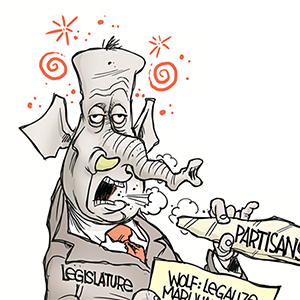Analysis: What we do and don't know about the fight for Congress
Published in Political News
WASHINGTON — Time did not bring clarity to the fight to control Congress. After nearly two years since the midterm elections and only days left before Nov. 5, it’s still not clear whether Republicans or Democrats will have a House majority next year.
While Republicans still have a clear advantage in the fight for control of the Senate, the fight for the House looks as close as the neck-and-neck presidential race. The final set of House ratings changes from Inside Elections (15 changes in total) demonstrates that close contest. Republicans are favored in 213 seats (rated as Solid, Likely, Lean or Tilt) and Democrats are favored in 214, and the eight toss-ups are divided evenly with each party currently representing four of them.
That means Democrats likely need to win four of the Toss-ups to get to 218 while Republicans need to win five. It’s the first time all cycle that Democrats are even slightly favored to win a majority in the district-by-district analysis.
Democratic chances for a majority increased as data showed they have a slight advantage in a handful of Toss-up districts. Inside Elections shifted six races from Toss-up to Tilt Democratic, including Iowa’s 1st District (represented by Republican Mariannette Miller-Meeks), Michigan’s 8th (Democrat Dan Kildee’s open seat), New York’s 4th (Republican Anthony D’Esposito), New York’s 19th (Republican Marc Molinaro), Oregon’s 5th (Republican Lori Chavez-DeRemer) and Virginia’s 7th (Democrat Abigail Spanberger’s open seat). GOP incumbents Juan Ciscomani (Arizona’s 6th) and David Valadao (California’s 22nd) saw their chances of winning decrease as well as their races shifted from Tilt Republican to Toss-up.
There was some good news for Republicans in the most recent round of ratings changes. Alaska’s at-large district (represented by Democrat Mary Peltola), Iowa’s 3rd (Republican Zach Nunn) and Michigan’s 7th (Democrat Elissa Slotkin’s open seat) all shifted from Toss-up to Tilt Republican.
With fewer Toss-up races, the overall likely range of outcomes narrowed as well to anything from a Democratic gain of nine seats to a Republican gain of one seat. While that looks like a significant Democratic advantage, the party needs a net gain of 4 seats for a majority, which is in the middle of the range, so the battle for the House is effectively a toss-up.
Texas Senate tilt
Republicans remain favored to win control of the Senate and most likely to gain from two to four seats. (They need to gain two for an outright majority.) But that total could creep higher considering GOP candidates are within striking distance in Pennsylvania, Wisconsin, Michigan and Nevada, and all of them could win if former President Donald Trump and the Republican Party have a great night.
On the other end of the spectrum, the door isn’t completely shut on Democrats maintaining control of the Senate due to a couple of late, emerging situations.
In Nebraska, a combination of Dan Osborn’s insurgent independent campaign and GOP Sen. Deb Fischer’s lack of a serious campaign means there’s a possibility that Republicans lose a seat in the Cornhusker State. Inside Elections has the Nebraska race rated Lean Republican.
Despite Fischer’s efforts to lose a winnable race, Republicans’ most vulnerable seat continues to be Texas.
While Republicans maintain GOP Sen. Ted Cruz is ahead in the mid-single digits, Democrats believe Rep. Colin Allred is running even with the incumbent. A Democrat hasn’t won statewide in more than 30 years, but Allred is still in the hunt in the closing days. Inside Elections changed the rating of the race from Lean Republican to Tilt Republican, one step closer to Toss-up.
Democrats are going to lose the West Virginia Senate seat, but GOP losses in Texas or Nebraska could offset further Democratic losses in, say, Montana and Ohio. That could allow Democrats to maintain control of the Senate as long as Vice President Kamala Harris wins the White House and Vice President Tim Walz is able to break tie votes.
Senate List
Moved toward Democrats :
Texas (Ted Cruz, R) from Lean Republican to Tilt Republican
House List
Moved toward Republicans :
Alaska’s at-large (Mary Peltola, D) from Toss-up to Tilt Republican
California’s 49th (Mike Levin, D) from Likely Democratic to Lean Democratic
Iowa’s 3rd (Zach Nunn, R) from Toss-up to Tilt Republican
Maryland’s 6th (Open; David Trone, D) from Likely Democratic to Lean Democratic
Michigan’s 7th (Open; Elissa Slotkin, D) from Toss-up to Tilt Republican
Moved toward Democrats :
Arizona’s 6th (Juan Ciscomani, R) from Tilt Republican to Toss-up
California’s 22nd (David Valadao, R) from Tilt Republican to Toss-up
Iowa’s 1st (Mariannette Miller-Meeks, R) from Toss-up to Tilt Democratic
Michigan’s 8th (Open; Dan Kildee, D) from Toss-up to Tilt Democratic
New Mexico’s 2nd (Gabe Vasquez, D) from Tilt Democratic to Lean Democratic
New York’s 4th (Anthony D’Esposito, R) from Toss-up to Tilt Democratic
New York’s 19th (Marc Molinaro, R) from Toss-up to Tilt Democratic
Oregon’s 5th (Lori Chavez-DeRemer, R) from Toss-up to Tilt Democratic
Virginia’s 7th (Open; Abigail Spanberger, D) from Toss-up to Tilt Democratic
Wisconsin’s 3rd (Derrick Van Orden, R) from Lean Republican to Tilt Republican
©2024 CQ-Roll Call, Inc., All Rights Reserved. Visit cqrollcall.com. Distributed by Tribune Content Agency, LLC.




























































Comments